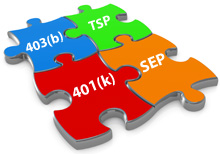 |
||
|
Stifel Client Account Access: LOG IN ● 1 Consolidate 2 Manage 3 Retire Well ● Contact Us |
||
| ROLLOVER CENTER |
Rollover
Options for Non-Spouse Beneficiaries of QRPs
Are you aware that a
non-spouse beneficiary, such as a child, grandchild, brother, or sister,
who inherits the assets from a Qualified Retirement Plan (QRP) is allowed
to roll the assets directly into a Traditional inherited beneficiary IRA,
or convert those assets to a Roth inherited beneficiary IRA?
Non-spouse
beneficiaries have traditionally not been permitted to roll over
inherited QRP (or IRA) assets into their own IRA.
However, under the Pension Protection Act of 2006 (PPA ‘06) and IRS
Notice 2008-30, a Traditional or Roth beneficiary IRA can now be
established and distributions flow from the deceased participant’s QRP
directly into the beneficiary IRA through a trustee-to-trustee transfer or
Roth conversion. When
converting into a Roth, the after-tax assets may be rolled tax-free and
any pre-tax assets converted will be taxed as ordinary income.
Although the transfer is technically called a “direct rollover,”
constructive receipt (checks payable to a beneficiary) must be avoided, as
rollovers received from non-spouse beneficiaries are not permitted.
Constructive receipt results in the loss of the benefit and
immediate taxation. Note that in
order to be eligible to roll to a Roth Beneficiary IRA, the beneficiary
must have less than $100,000 (single or joint) of adjusted gross income.
However, the $100,000
eligibility restriction is eliminated in 2010.
IRA rules must be followed
Once the assets are
received into a beneficiary IRA, all Required Minimum Distribution (RMD)
rules apply. Generally, if a
QRP participant was taking RMDs prior to his or her death, a beneficiary’s
RMDs will commence by December 31 of the year following the QRP owner’s
death, calculated based on the beneficiary’s single life expectancy,
determined by referencing the IRS
Single Life Expectancy Table. If
the deceased QRP participant was not taking RMDs, the five-year RMD option
may also be selected. With
this option, the entire balance of the beneficiary IRA must be distributed
before the end of the fifth year following the year of the QRP owner’s
death.
Beneficiary IRA advantages
By allowing direct
rollovers, non-spouse beneficiaries can:
·
Possibly defer taxes for a longer period of time – Some QRPs may
require a quicker payout period for non-spouse beneficiaries and life
expectancy RMDs may not be available, thus resulting in immediate
taxation.
·
Convert to a Roth beneficiary IRA if eligible – By converting
and paying any tax due now on the current value, as smaller RMDs are
received, potentially larger tax-free growth continues.
·
Preserve the Stretch IRA strategy – Once the assets are in
a beneficiary IRA,
the
beneficiary is allowed to name his or her own beneficiaries,
if the IRA custodian permits.
If the beneficiary of the inherited IRA dies before reaching
his or her full life expectancy, the IRA assets can continue to be paid to
the next beneficiary over the remaining distribution period of the
deceased beneficiary.
New opportunity
Because of PPA ’06 and Notice 2008-30, non-spouse beneficiaries of QRPs
are now offered the opportunity to establish
beneficiary IRAs at the institutions of their choice and self-direct the
assets within the products offered by that institution, rather than be
limited to the QRPs investments.
This information is for educational purposes only.
It is always recommended that you seek the aid of a competent tax
advisor or tax attorney to assist you with tax advice and guidance.
To better understand your options as a non-spouse beneficiary. Please take a minute to order a Rollover Kit. _ __________________________________________ |
Your Life. Your Money. Take Control Today! |
| Rollover Center Home | ||
| 401k ROLLOVERS | ||
| Order Rollover Kit | ||
| What is a 401k Rollover? | ||
| How Do I Start a Rollover? | ||
| ROLLOVER IRA s | ||
| Traditional IRA | ||
| Roth IRA | ||
| Which IRA is Best? | ||
| Investment Options | ||
| Contribution Limits | ||
| PLANNING | ||
| Retirement Planning | ||
| Estate Planning | ||
| Wealth Tracker | ||
| Wealth Strategist | ||
| RESOURCES | ||
| Search FAQs | ||
|
About Us |
||
|
|
||
 |

